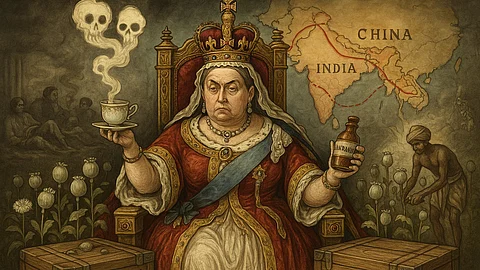
- Home
- न्यूजग्राम
- NewsGram USA
- India
- World
- Politics
- Entertainment
- Culture
- Lifestyle
- Economy
- Sports
- Sp. Coverage
- Misc.
- NewsGram Exclusive
- Jobs / Internships

Queen Victoria’s British Empire operated one of the largest state-sanctioned narcotics trades in history
Indian labour were used to cultivate opium on an industrial scale which ware then shipped to China.
Britain’s high demand for Chinese goods created a trade imbalance because China insisted on payment in silver, causing a silver shortage in Britain
When we study history, our textbooks are filled with kings, revolutions, and empires — but they tend to skip over one of the largest and most ruthless drug cartels in modern history. At its centre? Britain’s Queen Victoria, who reigned for more than six decades, and whose empire ran on the profits of a deadly narcotic: opium.
Beneath the imperial gloss and the Queen’s demure image lies a staggering truth. This wasn’t some shadowy underworld trade. It was a state-sanctioned, industrial-scale operation — powered by Indian labour, weaponised against China, and built into the very foundations of Britain’s imperial wealth.
By the late 1800s, India was cultivating opium on a massive scale. At the helm wasn’t a shady smuggler or a stereotypical zamindar, but the East India Company — and later, Queen Victoria herself. Roughly ten million Indians from eastern Uttar Pradesh and Bihar were forced into poppy cultivation. Colonial-run factories in Ghazipur and Patna processed the drug. Thousands of labourers pressed sticky latex into cakes, packed them into wooden chests, and shipped them off — their final destination: China.
Queen Victoria, arguably the greatest drug dealer of all time, presided over an empire that thrived on addiction. The story of how Britain addicted China and squeezed India dry is one of war, exploitation, and domination.
The system in India was brutally coercive. Small farmers were trapped by debt, unfair contracts, and violence. They were ordered to grow poppy instead of food. Historian Rolf Bauer notes that opium cultivation was a net loss for most peasants. Paid meagre sums, they still had to cover rent, irrigation, and labour costs. Refusal was not an option — colonial officers and landlords enforced strict quotas, while the police ensured obedience.
The destination for all this opium was China. Britain had a serious trade imbalance: it bought far more from China than it sold. Tea, silk, and porcelain were wildly popular in Britain, but Chinese merchants wanted little in return except silver. This drained Britain’s silver reserves.
The British solution was as cynical as it was lucrative — flood China with Indian opium. Colonial Shanghai became a city carved up like a roast duck by foreign greed. The addiction crisis was so deep it seemed as though Chinese lungs held more opium smoke than oxygen.
By 1838, Chinese authorities, alarmed by mass addiction and silver loss, cracked down. Commissioner Lin Zexu famously seized opium stockpiles from foreign traders and destroyed them. He also demanded traders sign bonds declaring they carried no opium — a demand the British refused.
Tensions escalated after the murder of a Chinese villager by British sailors, whom Britain refused to hand over for trial. Lin blockaded Macau, expelled the British to Hong Kong, and restricted their access to food.
On 4 September 1839, Britain responded with force, beginning the First Opium War. By 1842, China was defeated and forced to sign the Treaty of Nanking — ceding Hong Kong Island, paying compensation, and opening ports to British trade.
Britain wanted more: the legalisation of opium and wider market access. This led to the Second Opium War (1856–60), another defeat for China, and the Treaty of Tientsin, which gave Britain Kowloon and greater control. The final territorial grab came in 1898, when Britain leased the New Territories for 99 years — returned only in 1997.
Victoria herself consumed laudanum — an opium-and-alcohol tincture — almost daily. She also promoted chloroform for childbirth and cannabis for menstrual cramps. But while her own use was private and medicinal, her government’s export of opium was ruthlessly commercial.
By the mid-19th century, 15–20% of Britain’s colonial revenue came from Indian opium sales. The irony was stark: Britain’s moralists condemned addiction at home, while the empire’s overseas economy thrived on the very narcotic banned within its own borders.
This was never purely a British operation. Indian capital was deeply embedded in the trade. Bombay rose as a financial hub on opium profits.
The Parsi merchant elite—especially Jamsetjee Jejeebhoy—made vast fortunes exporting Malwa opium to China. Jejeebhoy, who began as a humble batliwalla (bottle-seller), became a shipping magnate and was later knighted as a baronet. He funded hospitals and charities—all from narcotics wealth. Even the Tata family’s earliest ventures began in opium before shifting to cotton.
The drug quite literally underwrote Bombay’s modernity, bankrolling India’s first generation of industrialists. The city’s glittering skyline still rests on the hazy scaffolding of that past.
In Bihar and eastern UP, poppy fields left behind poverty and underdevelopment that persist today. In western India, drug profits helped build industries and cities. The opium trade deepened caste and class divides, bound Indian elites to colonial power, and shaped the modern economic map.
Queen Victoria’s Opium Empire thrived on addiction, destabilised Asia, and exploited India — all under the banner of “civilisation.” Our schoolbooks rarely mention the poppy warehouses, the drowned Chinese sailors, or the emptied Indian villages. But to look at the Indian opium trade through an Indian lens is to confront imperial hypocrisy head-on. [Rh/VP]
